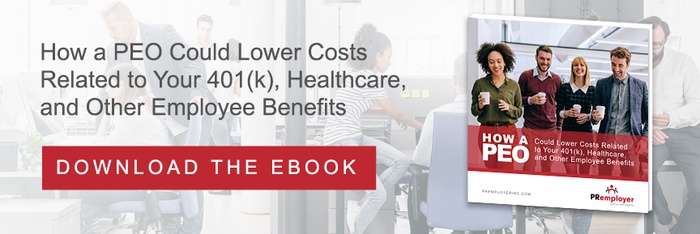
While you don't technically have to provide benefits, with some exceptions for businesses of a certain size, not providing a good benefits package makes it hard for you to attract good employees and harder still to keep them. By benefits, we're referring to items such as healthcare, retirement plans, and disability insurance, which most companies traditionally offer.
Unfortunately for smaller companies, benefits have a significant cost. The total cost of life, health, and disability insurance averages $2.83 for each hour worked, and retirement averages $1.25. Larger companies pay less and smaller companies pay more simply due to economies of scale. Costs also vary heavily by location.
Providing a good benefits package is vital to retaining talent—as long as you keep it affordable. Designing an efficient benefits package balances these things to keep costs low.
Designing Your Benefits Package
Good benefits meet both your company's needs and those of your employees. An efficient benefits package accounts for your budget and your employees' specific needs. It is vital to listen to employees about their needs when you design your package and consider future needs. Here we'll go over best practices to accomplish this.
Identify Your Objectives and Budget
Start by taking your existing knowledge and establishing your ideal benefits package while keeping your goals in mind. Consider the onboarding practices involved in hiring and retaining employees. Then you need to establish your budget, which is how much you are willing and able to spend.
When establishing goals, consider your size, location, and industry. One good way to do this is to find out what other organizations offer, both in your industry and across industries for universal positions, such as HR specialists. Look at what benefits your employees are using as well as what you know they want.
There are likely to be some differences between you and your employees on their key objectives, and they may have a wish list that you already know you won't be able to meet. But it's very important that they feel heard and have a good employee experience.
Formulate Your Benefits Plan Program
Now, you need to formulate the actual design. You need to list out what you want to offer and then assess how much it costs.
Developing your benefits is not a simple process. You need to compare cost savings, determine what you can or need to outsource, and then establish which offerings can most feasibly be excluded. The chances are that you won't be able to afford your dream benefits package, at least at first.
At this stage, you will need a benefits consultant. A benefits consultant can help you navigate benefits complexities and identify what options are available. You can also lean on their experience since they can inform you of better options or more efficient and cost-effective ways to achieve your goals.
Communicate Changes to Your Employees
Once you have your plan, you need to explain it to your employees. It's vital that every employee understands any significant changes to benefits clearly and directly. You want to make sure they know what options are newly available to start taking advantage of them. You also need to be ahead in communicating why changes occur, especially if they look like changes for the worst. For example, if you decide to remove a benefit that nobody is using, people may still not want to see it go. Make sure you get ahead of the discussion by explaining any changes and helping people find suitable alternatives. Also, let employees know how you utilized their input to show you value and listen to them.
This step is crucial to increase awareness. Also, if you add benefits, significantly less usual ones, you need to make sure the people who will use them know about them. It's easy to add a benefit, not properly inform your employees, and then find out later nobody is using it. Make sure that benefits are communicated clearly to existing employees, not just new hires.
Ongoing communication and acceptance of feedback are vital to maintain employee morale and ensure everyone is happy.
Periodically Evaluate Your Benefits Effectiveness
It's far too easy to set up a benefits package then let it sit unused. You should be checking how employees put their benefits to use and whether they are regularly appreciated. Compare actual use to the goals and objectives you set.
By properly auditing your benefits, you can work out if you are moving in the right direction. Surveying employees and conducting needs assessments help you evaluate your ongoing success. It also allows you to be more experimental and try out new things that employees have said they want, knowing you can always remove them if they turn out to be unused.
Designing the right benefits package is a lengthy and complex process. The vast majority of companies need help with it at some point, especially when it comes to working out what is available and what you can afford.
Working with a PEO can help. A PEO can act as your benefits consultant, using their knowledge and experience to help you craft the right package. They already know what is available and what you can afford.
Furthermore, because a PEO acts as the employer of record, you gain access to their benefits plan, resulting in significant financial savings and often the ability to afford benefits that would otherwise be beyond your reach. They can also help with your benefits administration and free up your HR team for more complex and nuanced matters. Partnering with a PEO will help you set up the right employee benefits program that saves you money (and time).

